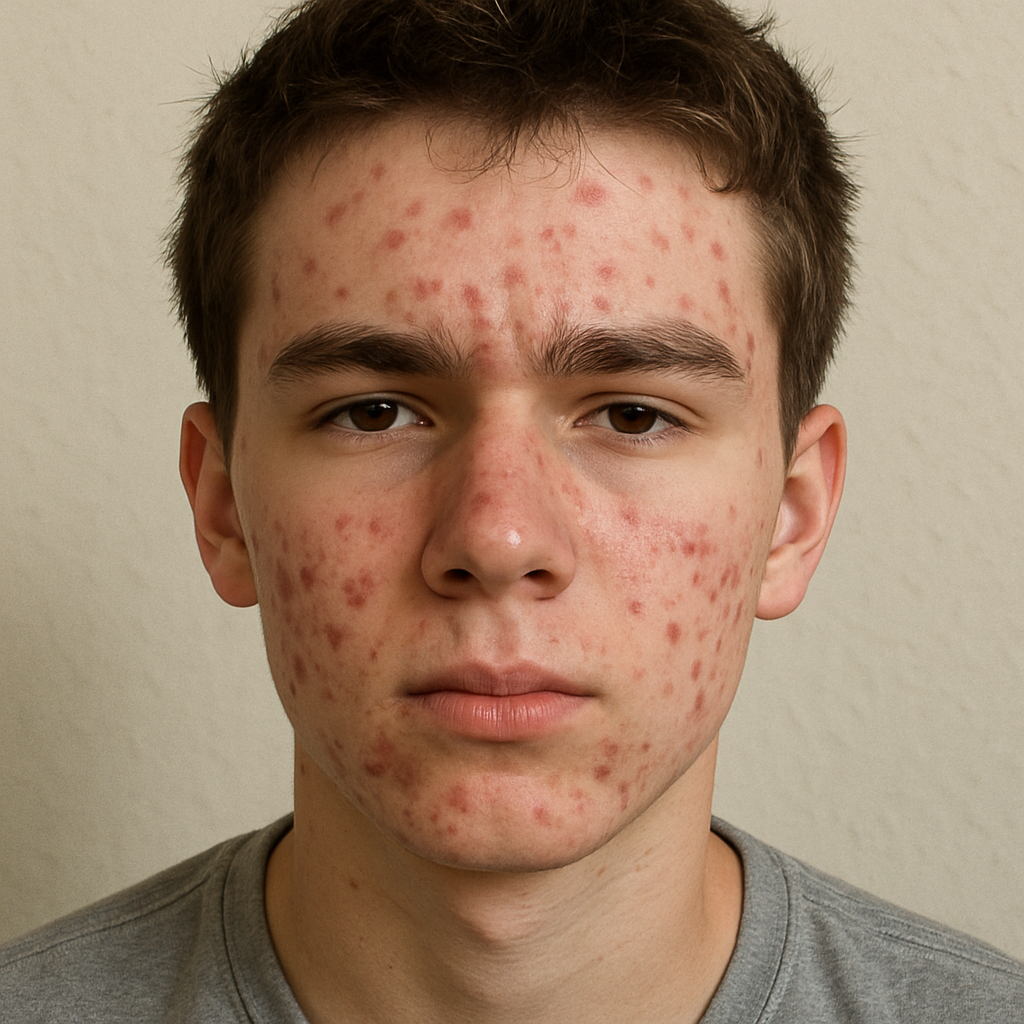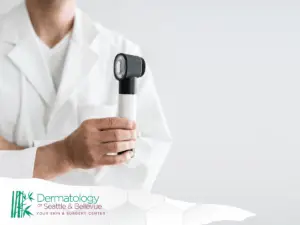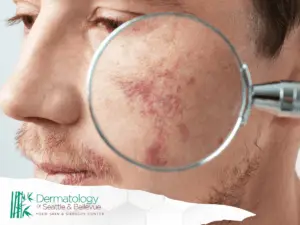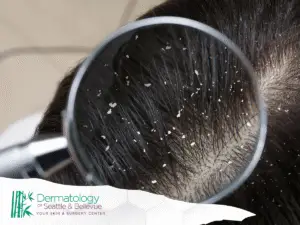How Hormones Affect Your Skin at Every Life Stage
Hormones influence your skin from puberty all the way through adulthood, pregnancy, and menopause. During adolescence, testosterone and other androgens increase oil production, often causing acne and clogged pores. Later in life, hormonal imbalance symptoms, such as changes in estrogen during menstrual cycles, pregnancy skin changes, and menopausal shifts, continue to affect hydration, elasticity, and sensitivity. Understanding how testosterone affects oily skin, how estrogen maintains firmness, and how hormones create cyclic acne patterns helps you tailor your skincare routine to each life stage. Dermatologists at Dermatology of Seattle can provide guidance on acne and hormones, melasma care, and skin changes related to pregnancy or menopause.
The Surge of Androgens
During puberty, androgen levels rise sharply in both boys and girls. These hormones stimulate sebaceous glands, increasing sebum and making skin more prone to clogged pores and breakouts.
The onset of puberty brings a significant increase in androgen hormones, especially testosterone. These hormones activate the sebaceous glands, boosting oil production. While natural oils protect the skin barrier, excessive sebum can mix with dead skin cells and clog pores. Understanding how testosterone and oily skin are connected helps families manage early acne more effectively.
Identifying Hormonal Acne
Hormonal acne typically appears on the face, chest, or back and often flares cyclically. These patterns help differentiate it from other acne types.
Hormonal acne can range from whiteheads and blackheads to deeper cystic lesions. It often follows predictable cycles related to hormonal fluctuations, especially around menstruation. These flare patterns are key signs of the connection between acne and hormones, helping dermatologists determine whether topical products, oral medications, or hormonal therapy may be most effective.
Addressing Teenage Skin Concerns
Supporting teenage skin involves gentle routines, balanced nutrition, and early education about healthy skincare habits.
Beyond basic acne medications, teenagers benefit from a broader approach to skin health. Diets rich in omega-3s, antioxidants, and zinc can help regulate inflammation. Gentle cleansers, non-comedogenic moisturizers, and avoiding harsh scrubs protect the skin barrier. Establishing good habits early can reduce long-term scarring and help teens manage hormonal imbalance symptoms more confidently.
Adulthood: Hormones and Skin Health

Women may notice recurring breakouts, sensitivity, or pigmentation changes as hormone levels rise and fall. Recognizing these patterns allows for more targeted skincare, especially during life stages where estrogen levels directly influence hydration, firmness, and overall skin elasticity.
The Menstrual Cycle’s Impact
Monthly hormonal fluctuations affect hydration, oil production, and skin sensitivity. Adjusting skincare through each cycle can help maintain balance.
Estrogen peaks during certain phases, helping maintain skin elasticity and hydration. When estrogen levels dip in the luteal phase, many women notice dryness or increased breakouts. Tailoring skincare – such as adding light exfoliation mid-cycle and extra hydration pre-menstruation – helps support skin through these natural shifts.
Pregnancy and Skin Changes
Pregnancy can trigger pigmentation changes, new sensitivities, or acne due to fluctuating hormone levels.
Pregnancy dramatically alters hormone balance, sometimes leading to pregnancy skin changes like melasma, acne, or increased redness. Elevated estrogen can make skin more sensitive, while progesterone changes may increase oil production. Expectant mothers should use pregnancy-safe products and consult a dermatologist for conditions like melasma, which often require gentle but targeted care.
Navigating Menopause
Declining estrogen during menopause leads to drier, thinner, and more sensitive skin. Supportive skincare helps maintain comfort and firmness.
Menopause triggers a marked drop in estrogen levels, which reduces natural moisture and collagen support. This can lead to dryness, more visible lines, and heightened sun sensitivity. Incorporating hydrating ingredients, phytoestrogens, and daily SPF can help women manage these changes. Dermatologists may also recommend treatments focused on restoring firmness and improving estrogen-related skin elasticity.
Middle Age: Hormones and Aging

During middle age, levels of estrogen and testosterone decline in both men and women. These shifts can accelerate visible aging, reduce skin elasticity, and increase dryness. Recognizing hormonal imbalance symptoms early allows for more targeted skincare strategies.
Recognizing Hormonal Imbalance Symptoms
As hormone levels decrease, many people notice changes such as dryness, dullness, sagging, or an increase in fine lines. These symptoms often reflect a gradual loss of collagen support and reduced skin elasticity. Identifying these changes early helps guide treatment decisions, including whether lifestyle adjustments, skincare upgrades, or medical therapies are appropriate.
Enhancing Skin Resilience
Middle-aged individuals can strengthen their skin’s resilience with a combination of lifestyle habits and dermatology-backed ingredients. Antioxidants like vitamin C help minimize free-radical damage, while retinoids support healthy collagen turnover. Regular exercise and diets rich in omega-3 fatty acids can also support cellular repair and keep skin looking more vibrant.
Hormone Replacement Therapy Considerations
Hormone replacement therapy (HRT) may help improve menopausal symptoms, including dryness and loss of firmness. Some patients experience enhanced hydration and improved elasticity with HRT, but it isn’t right for everyone. Consulting a qualified healthcare provider ensures a personalized, safe approach that considers medical history, risks, and desired outcomes.
Senior Years: Maintaining Skin Health

In later adulthood, natural declines in collagen and elastin make skin more fragile and sensitive. Adjusting skincare routines to focus on hydration, protection, and regular dermatological check-ups helps maintain skin comfort and reduce risks.
Combatting Increased Dryness
Senior skin produces less oil and holds less moisture, making gentle hydration essential. Cleansers with mild surfactants, plus moisturizers containing glycerin or hyaluronic acid, help replenish moisture without irritation. Ingredients like aloe vera or ceramides can further strengthen comfort and reduce sensitivity.
Supporting Skin Barrier Function
The skin barrier weakens with age, increasing susceptibility to irritation and environmental stressors. Occlusive ingredients such as petrolatum or mineral oil lock in moisture and prevent dryness-related cracking. Supporting barrier repair becomes crucial for preventing itching, redness, or infections.
Importance of Regular Check-Ups
Routine dermatology visits help detect early signs of age-related concerns, such as actinic keratoses, suspicious lesions, or skin cancer. Early evaluation is particularly important for seniors with a history of sun exposure. Regular check-ups also allow dermatologists to adjust skincare recommendations based on ongoing hormonal and structural changes.
Practical Advice for All Ages
No matter your stage of life, healthy, balanced habits support long-term skin wellness. Hormones shift constantly, and your skincare routine should evolve with those changes.
Stay Hydrated
Consistent hydration supports natural elasticity and improves skin resilience. Water-rich foods, like cucumber, citrus fruits, and watermelon, help supplement daily fluid intake for a healthier glow.
Prioritize Sun Protection
Sun protection remains one of the most important lifelong skincare habits. Daily SPF 30 or higher helps prevent UV-related aging, sun spots, and skin cancer. Wide-brimmed hats, UV-blocking clothing, and regular sunscreen reapplication add extra protection during extended time outdoors.
Embrace a Balanced Diet
Antioxidant-rich foods such as leafy greens, berries, and colorful vegetables help reduce oxidative stress. Lean proteins support collagen formation, while nuts, seeds, and healthy fats promote long-lasting elasticity. A nutrient-diverse diet enhances skin strength from within.
Manage Stress Effectively
Stress can intensify hormonal fluctuations, leading to breakouts, dryness, or sensitivity. Techniques such as yoga, meditation, deep breathing, and mindfulness help regulate stress pathways and support overall skin wellness.
Consult a Professional
Dermatologists can help create customized routines based on hormonal stage, skin type, and individual concerns. For some, this may include prescriptions, in-office treatments, or recommendations for managing hormonal imbalance symptoms. Professional guidance ensures that skincare evolves alongside your body’s natural changes.
Conclusion
Hormones influence your skin throughout every stage of life, from oily teenage skin driven by androgen surges to menopausal dryness linked to declining estrogen. Recognizing early signs of hormonal imbalance and tailoring your skincare to your changing needs empowers you to stay proactive. With consistent routines, healthy lifestyle habits, and guidance from a dermatologist, you can support strong, resilient skin at any age.
For personalized care, the dermatologists at Dermatology of Seattle in Seattle, Bellevue, and Burien can help you understand your unique hormonal skin patterns and create a plan that evolves with you.






